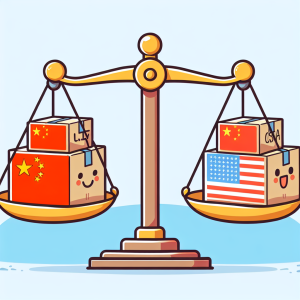The ripple effects of U.S. President Donald Trump’s aggressive tariff policies are being felt far beyond American shores, with Singapore emerging as a notable indirect casualty. As the global financial landscape grapples with the consequences of these tariffs, analysts warn that the city-state’s economy could face significant challenges stemming from the ongoing trade tensions between the U.S. and its major trading partners, including China, Canada, and Mexico.
The tariffs imposed by the Trump administration, which include a baseline of 10% on various imports and additional levies as high as 60% on Chinese goods, have ignited a trade war that has sent shockwaves through international markets. Singapore, as a small and highly trade-dependent economy, is particularly vulnerable to fluctuations in global trade dynamics. The Straits Times notes that the indirect impact of these tariffs could manifest through reduced demand for Singaporean exports, particularly in sectors heavily reliant on trade with China and the U.S.
The economic repercussions of these tariffs extend beyond immediate trade losses. Analysts project that U.S. GDP could decline by as much as 0.8% due to retaliatory measures affecting around $330 billion of U.S. exports. This decline is likely to dampen global economic growth, with Singapore potentially facing reduced foreign investment and slower economic expansion as a result. The recent volatility in stock markets, including sharp declines in major indexes like the S&P 500 and Dow Jones, further underscores the uncertainty that these tariffs have introduced into the global economy.
Inflationary Pressures and Consumer Costs
Despite President Trump’s assertions that tariffs would not lead to increased prices, evidence suggests otherwise. The tariffs have contributed to rising consumer prices and input costs, resulting in inflationary pressures that could affect Singaporean consumers and businesses alike. The increase in federal tax revenues, projected at $258.4 billion in 2025—the largest tax hike since 1982—comes at a significant cost to economic output and employment. Analysts, including JPMorgan CEO Jamie Dimon, have raised concerns about the potential for a slowing economy driven by these rising costs.
Moreover, the retaliatory tariffs imposed by countries like China, which has enacted a 34% tariff on U.S. goods, have exacerbated the situation. As these countries seek to protect their own economic interests, Singaporean businesses that rely on a stable trade environment could find themselves facing higher costs and reduced market access.
Global Trade Dynamics and Future Outlook
The ongoing trade tensions have prompted discussions among global trading partners about potential countermeasures. The European Union, for instance, is considering reducing tariffs on industrial products in response to U.S. actions. Such shifts in policy could alter the landscape of international trade and impact Singapore’s position as a regional trade hub.
As Singapore navigates these turbulent waters, it is crucial for policymakers to remain vigilant and responsive to the evolving trade environment. The interplay between U.S. tariff policies and global economic stability highlights the interconnectedness of modern economies and the need for strategic planning to mitigate risks.
In conclusion, while Singapore may not be the direct target of Trump’s tariffs, the indirect effects are significant and warrant attention. The city-state must brace for potential economic headwinds as the global trade landscape continues to shift, emphasizing the importance of adaptability in an increasingly complex world.





